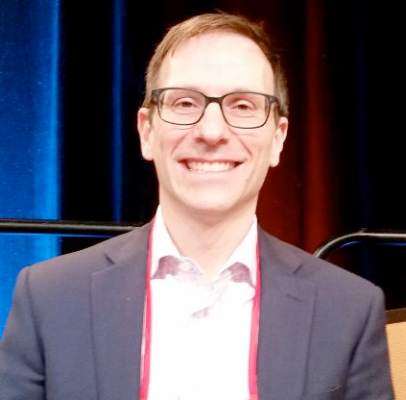EXPERT ANALYSIS FROM THE 2017 BMT TANDEM MEETINGS
ORLANDO (FRONTLINE MEDICAL NEWS) – Performing a comprehensive geriatric assessment of patients with acute myeloid leukemia (AML) does more than provide fine-tuned risk stratification; spotting areas of vulnerability and frailty can also identify targets for prehabilitation, support, and remediation as older patients face transplant.
A program at the University of Chicago termed the Transplant Optimization Program, or TOP , uses the geriatric assessment as the foundation of an interdisciplinary, customized intervention for older adults facing hematopoietic cell transplant (HCT). The team includes the transplant physician and a geriatric oncologist; however, social work, dietetics, psychology, and physical therapy professionals also are brought on board.
The global assessment is warranted because patients aged 50 years and older already have a high prevalence of vulnerabilities when their frailty is assessed preallograft, said Andrew Artz, MD , in an aging-focused session at the combined annual meetings of the Center for International Blood & Marrow Transplant Research and the American Society of Blood and Marrow Transplantation. Previous work, he said, had shown that the risk of non–relapse related mortality after nonmyeloablative HCT in patients aged 60 years or older was directly and significantly associated with higher comorbidity scores; age alone, by contrast, was not associated with increased non-relapse mortality. Other research had shown that slow walk speed, low mental health, low albumin, and high C-reactive protein levels were all prognostic of poor allograft outcomes for patients aged 50 years and over. However, Dr. Artz said, the same study found that impairment in instrumental activities of daily living – activities that allow an individual to live independently in the community, such as using a telephone, managing one’s own money and medications, and being able to prepare one’s own meals – was the strongest predictor of poor allograft outcome.
“High comorbidities and functional limitations influence overall survival,” Dr. Artz said. “Non-relapse mortality remains a major barrier; of course, the attendant morbidity before it is perhaps a bigger concern, and our patients’ concern.”
Dr. Artz said that he and his colleagues at the University of Chicago, where he is a professor of medicine, had adapted the geriatric assessment developed by the Cancer and Aging Group, and now administer it to all prospective transplant patients aged 50 years and older. Dr. Artz said that, at his center, they have found that 25% of patients aged 50 and older were frail according to the Fried Frailty Index . “That’s what we expect for people in the community who are aged 80 and older, so we’re painting a picture of accelerated aging for patients before they undergo allograft,” he said.
Results of the assessment are then reviewed by a multidisciplinary team, and an individualized prehabilitation and support program is developed based on those results. “Using chronologic and physiologic age in transplant can help us better risk stratify, and think about strategies to mitigate some of those risks,” Dr. Artz said.
The staging tool currently used at the University of Chicago examines seven domains and uses objective tools to deliver information in each domain. Comorbidities are assessed by the Hematopoietic Cell Transplant–Specific Comorbidity Index ( HCT-CI ) and the Older Americans Resources and Services ( OARS ) scale. “We are trying to use standardized tools such as the geriatric assessment, because our ‘eyeball test’ is quite poor,” he said.
Physical function is assessed by measuring four-meter walk speed and grip strength; by asking about falls and capacity for instrumental activities of daily living; and by administering the Karnofsky Performance Scale–MD. Patients are given the Mental Health Inventory–17 to assess psychological health.
Neurocognitive testing and the Blessed Orientation-Memory-Concentration test are used to assess cognitive function. The Medical Outcomes Study Social Activity and Social Limitations scales give an idea about social support.
Biomarkers that are tracked include C-reactive protein and ferritin, among others, Dr. Artz said. Nutritional status is assessed by measuring serum albumin as well as any weight loss.
Once the full geriatric assessment data about a patient are gathered, a plan is formulated for impairments in any given domain. For example, if significant comorbid conditions exist, the TOP team seeks subspecialty consultation for management advice in the context of transplant. “This is a consultation – not a clearance!” Dr. Artz said.
Physical and functional impairments are addressed with prehabilitation if time permits, and the home assessment is aligned with patient expectations. Sometimes, the inactivity associated with peritransplant period can worsen conditions such as osteoarthritis, so a patient who’s been functional may find themselves very stiff when going home. Caregivers can encourage early activity to help minimize this effect, Dr. Artz said.
For patients at nutritional risk, it’s vital to have a good nutrition plan for transplant and to make sure medications or social factors aren’t standing in the way of adequate nutrition, Dr. Artz said. “Don’t forget to ask about dentures,” he said, since mucositis can make dentures unbearable in the immediate posttransplant period.
It’s important to be careful when unpacking findings of cognitive impairment, Dr. Artz said, since untreated depression and anxiety can manifest as forgetfulness and perseveration. Eliminating unnecessary medication, having a good delirium protocol in place, and keeping a family member in the room with the patient can help minimize a cognitive downturn during transplant.
As patients age, it can be more common for them to have limited social support. The TOP team calls a family meeting to assess resources and appoint a “team captain” among the patient’s social circle. “We work to enlarge that circle,” by pulling in as many family members and friends as possible, Dr. Artz said. In a discussion after the talk, he said that he feels that having a family member in the hospital with the older transplant patient is important for many reasons. Not only is the patient less likely to fall, he or she may also eat better and feel better. In addition, Also, he said he has a sense that when the caregiver has seen the patient at his or her nadir, taking that patient home isn’t as scary, since it’s easier to see that the trajectory is headed upward by the time of discharge.
Dr. Artz said that other facilities are now beginning to send patients for TOP evaluations; “the aging evaluation informs physiologic age, candidacy for transplant, and may permit optimizing outcomes,” he said. “We’re trying to … optimize patients both before and after transplant. It’s one thing to say you’re vulnerable, but how do you take that vulnerable patient and improve their outcomes? That’s the question.” Though the proportion of older individuals receiving allogeneic transplants is growing rapidly, research is not keeping up, Dr. Artz said, calling for more prospective studies in older adults.
Dr. Artz reported that he has received research funding from Miltenyi Biotech.
koakes@frontlinemedcom.com
On Twitter @karioakes






